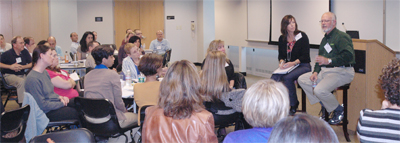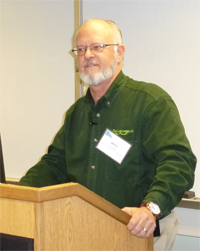|
To Bill Clark, putting a man on the moon and bringing him back safely was relatively simple – a “tame” problem in the parlance of strategic organizational dynamics. Clark prefers to work in a critical area of what are called “wicked” problems – ending hunger. As an avowed “hunger missionary” wandering in what the USDA calls the “food desert,” Clark has been President & Executive Director of Philabundance since 2001. Clark had spoken at Your Part-Time Controller’s first all-staff block training several years ago, and returned in October, 2012 to give YPTC staff a “Lunch and Learn” briefing on the status of hunger in American communities today.  YPTC Partner Jennifer Alleva and Philabundance President and Executive Director Bill Clark address Your Part-Time Controller’s 2012 all-staff block training. “Wicked” problems are intractable, multi-dimensional societal concerns with interlocking issues and restraints and no definable solutions. They involve so many stakeholders that resolution by necessity has to be a social issue. They are constrained by political ramifications that continually change over time and by operational issues that continually evolve under new stakeholders and regulations. They have a no-stopping rule: you can’t define when the problem has been solved, for if you feed all the hungry people today there will still be more tomorrow and more still 10 years from now. They are often a by-product of other wicked problems, such as hunger being deeply affected by issues of poverty and low levels of education. “Solving hunger should not be hard,” said Clark. “Everyone believes hunger is bad, it’s a non-partisan issue, and every faith in the world admonishes its followers to feed the hungry. Hunger is often associated with poverty. “But the two are different. Poverty is relative: no matter how affluent our society gets, there will always be 10 to 15% of the population who will be poor, even if someone at the poverty level in America would be considered wealthy in Somalia. But hunger is biological. A child in the U.S. or in Somalia needs the same amount of caloric intake.” Clark has no ready explanation for why the richest nation on Earth can have so many people going hungry, or why the recession has caused hunger to break into the middle and working classes. But to address these disparities he has moved Philabundance into becoming the largest hunger relief organizations in the Delaware Valley, and one of the premier such institutions nationally among 200 community food banks covering every American county. Philabundance’s 140 employees and dozens of volunteers process tons of donated food, sort it, and repackage it for distribution to a network of over 500 community and faith-based pantries, kitchens and cupboards that feed some 65,000 residents each week. “There are people tonight who will have food on their table as a direct result of what this organization is doing, and when I go home that’s a great feeling,” he said. The community food bank movement is a relatively new one, having started only in 1980, with Philabundance coming into existence a mere two years later. The movement has experienced incredibly rapid growth and has undergone major evolutionary changes. “Back when the movement started, it was based upon three assumptions: that the faith community would always take care of the need, that we Americans waste so much food there is always plenty to give away, and that with a reduction in the rates of poverty hunger would be eliminated,” he said. All three assumptions have been challenged over the years. It For example, many church food kitchens are staffed only by volunteers during irregular daytime hours so they may not be open during evenings when the working poor can access them. And some neighborhoods are so poor that they cannot even support a church, and those that do may not be able to support a food pantry. Meanwhile, vast swathes of urban areas are what the USDA calls “food deserts” – places where residents have limited or no access to affordable and nutritious food. There are 35 such food deserts in the Delaware Valley alone. When the last grocery stores in a neighborhood close, food cupboards are overwhelmed with demand not only from the poor but from other neighbors who simply have no place else to shop. One such community is Chester, Penna., an economically distressed city of 65,000 people that used to have five grocery stores and which since 2001 has had none. To address this issue, Philabundance has taken a unique step and bought the vacant building that had housed Chester’s last supermarket to create Fair & Square, a nonprofit grocery that will offer food on a reliable basis at a low cost. Other food banks have applied vertical integration techniques by capturing production aspects of the food supply chain, such as buying farms, food processing plants and even fishing boats. Philabundance is integrating into the distribution chain through social entrepreneurship that aims at sustainability. Fair & Square is believed to be the first supermarket in the country to be operated by a food aid group as a nonprofit venture. A UNIQUE NONPROFIT BUSINESS MODEL
|
 Bill Clark Philabundance The Chester venture is designed to be scalable. “If it works in Chester we can do it in Trenton, Atlantic City, Harlem, Wilmington, Philadelphia – in any areas that are devoid of grocery stores where there are cores of need,” Clark told YPTC’s staff. Philabundance has had a long experience of operating its own community food distribution centers, of which there are 13 today where customers can pick the items they need off shelves. It’s a more normal shopping experience than just getting a handout, he said, as it both promotes a stronger sense of dignity and allows people to choose what they will actually eat. But demand became so great that the organization was forced to buy food in order to give it away – what Clark called an organizational culture shock and “a bad strategic path to go down” unless recipients help pay for the food. If food banks just give people food, it becomes a subsidy and when the food runs out they can no longer help the people. If the food banks buy food and give it away, it’s a financial loss and they cannot afford that business model, either. But if they use a combination of donated and purchased food, and sell it in community stores at an affordable price with only a slight profit margin, the program is sustainable long-term. THE DOCTRINES OF FOOD RELIEFClark likens the War on Hunger to a military approach in that both groups rely on “doctrines” of codified beliefs of how they will fight a particular war. As the hunger-fighting field has evolved, new doctrines have taken prominence and the result has been new and innovative business models. Food banks started out with a logistics doctrine: the way to end hunger was to put food in front of hungry people, they said. Other doctrines over the years have favored education, public policy and economic development. “But with a mission as broad and as aspirational as ending hunger, almost anything you try can fit the mission, so there’s a real danger of mission creep. It is important for me to determine not only what we will do but also what we will not do, as a way to narrow our focus and avoid mission drift.” Clark is now working on what he calls the engagement doctrine. “Since the problems of hunger are so incredibly complex, an individual response is not as effective as a collaborative one. Given that the issues and constraints affecting hunger are dynamic and continually changing, the solution lies in impacting multiple levels simultaneously. “The problem of hunger will not be solved until society reaches a tipping point where it’s no longer socially acceptable, when people have no tolerance for hunger,” he said, describing how similar tipping points were reached regarding universal public education, women’s rights and the abolition of slavery. “We need to keep the community engaged in the fight, and to treat the organizations we work with not as competitors but as collaborators. We make changes by little increments.” What can an individual do under this engagement doctrine? “Think of it like a political campaign,” he said. “Everyone has a best way to support their candidate. Some of us can write a check. Some can go door-to-door. Some can write a letter. Some can volunteer or organize a group to volunteer. But whatever your cause is, you’ve got to do whatever you can to change the world because we all want to design the society we want our grandchildren to live in. Sitting back and expecting others to do it and not getting engaged isn’t going to work. You’ve got to fly your flag.” |
Solving Hunger in the Urban “Food Desert”


 ’s not just a matter of logistics or of saying that the way to end hunger is to put food in front of hungry people, he said. Providing the right food to the right people in the right quantity at the right time and the right place requires powerful logistics. “And finding the right time and place were not as easy as we had thought,” he said.
’s not just a matter of logistics or of saying that the way to end hunger is to put food in front of hungry people, he said. Providing the right food to the right people in the right quantity at the right time and the right place requires powerful logistics. “And finding the right time and place were not as easy as we had thought,” he said.



